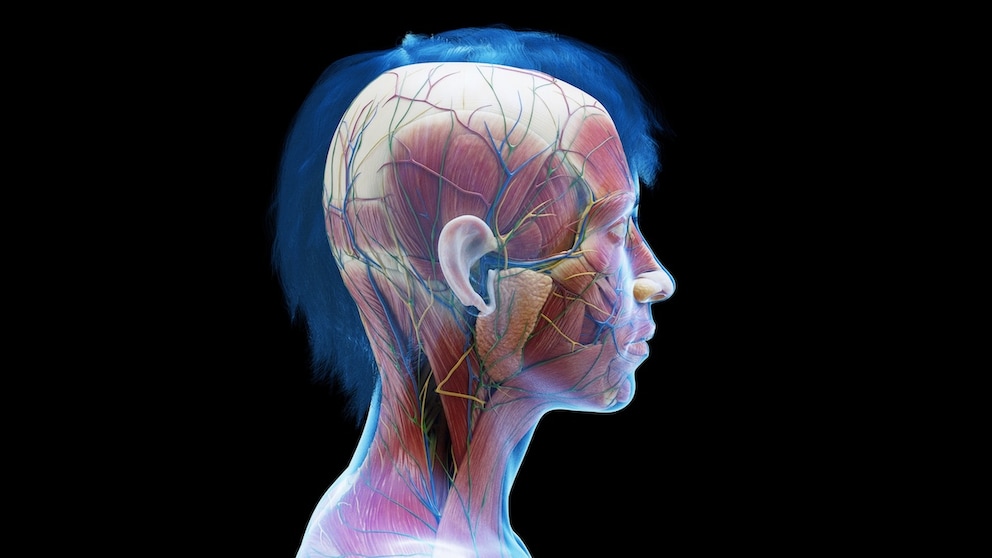March 20, 2025, 2:42 pm | Read time: 5 minutes
Chewing is an everyday function that is often underestimated — but it could have a significant impact on our health. A new study from Japan investigated the possible consequences of muscle loss in the chewing muscles.
The chewing muscles are made up of four muscles in the head area: the large chewing muscle, the temporal muscle, and the inner and outer wing muscles. These allow you to open and close your mouth. They also make a significant contribution to gliding movements when biting and grinding food. However, as muscle strength decreases with age, so does the ability to chew food efficiently. This limitation could have more far-reaching consequences than previously assumed. A recent study from Japan examined for the first time how weak chewing muscles are associated with physical performance — i.e., muscle mass, strength, and body weight — on a gender-specific basis.
Overview
Different Chewing Patterns in Men and Women
The study investigated whether weakened masticatory muscles are associated with overall muscle loss, physical performance, and body composition in older adults. Previous research on this topic has been inconsistent, particularly because gender differences have not been adequately addressed.1
It is known that men and women have different chewing and muscle patterns: Men generally have stronger chewing muscles and higher muscle mass, while women often chew more slowly and with less force. In addition, women with limited chewing muscles tend to prefer soft and high-calorie foods.2 These differences may explain why previous studies have not produced consistent results.
Therefore, the current study aimed to analyze the relationship between chewing ability and muscle health separately for men and women. In addition, a distinction was made between objective (measurable) and subjective (self-assessed) chewing problems in order to find out which method provides a more reliable assessment.
Determination of Chewing Performance and Body Composition
The study was based on data from the previous Shizuoka Study, a large long-term study in Japan. For the present research, data from the period between December 2021 and March 2024 was used from a total of 1440 people who were 65 years or older at the time of the survey.3
Survey of Performance of Chewing Muscles
- Objective: The participants chewed a standardized piece of fruit gum 30 times and spat out the crushed pieces. The number of pieces chewed was recorded photographically and analyzed using software.
- Subjective: A questionnaire recorded the self-assessment of chewing ability from “I can eat everything” to “I can hardly chew.”
Measurement of Muscle Health and Body Composition
- Skeletal muscle mass: Measured using bioelectrical impedance analysis.
- Hand grip strength: Measured with a hand force meter.
- Walking speed: Determined on a 10-meter path with light barriers.
- Five-time stand-up test: Duration for five repetitions from a sitting position.
- Body weight and waist circumference: Standardized measurements using scales and measuring tape.
In addition, dietary habits were recorded using a questionnaire. Statistical analyses took into account age, nutritional factors, and other influencing variables.
Gender-Specific Effects Due to Reduced Chewing Performance
The results showed clear gender-specific differences in the link between chewing performance and physical health. For example, men with limited or weakened chewing muscles showed weaker hand grip strength and slower walking speed. In women, on the other hand, reduced chewing muscles tended to be reflected in an increased BMI and larger abdominal circumferences.
The researchers came across another remarkable finding: around 40 percent of participants with poor objective chewing performance rated their chewing ability as normal. In contrast, people who rated their chewing behavior as problematic showed no statistically relevant correlations with muscle health or body weight.
The Influence of Weakened Chewing Muscles on Health
The study underlines that chewing performance could play a central role in muscle health and body composition or physical performance in old age.
The researchers suspect that weak chewing muscles in men could possibly mean lower protein intake, which accelerates muscle loss. In addition, reduced chewing performance could be a sign of general muscle degeneration that also affects other areas of the body.
In women, the results could support the previously mentioned hypothesis that chewing problems lead to a change in diet — possibly towards softer, higher-calorie foods, which promotes weight gain.
It is particularly critical that many people are not aware of their chewing problems. This could result in necessary dietary adjustments or medical measures not being taken.
Classification of the Study
The study provides valuable findings but also has limitations. As this is a cross-sectional study, the results provide no evidence of causality. It, therefore, remains unclear whether weak chewing muscles cause muscle loss or weight gain or vice versa.
All subjects were physically independent and healthy, so the results may not be transferable to frailer older people. In addition, the food intake questionnaire was based on self-assessments by the participants, which may lead to inaccuracies.
Despite these limitations, the study shows that chewing problems may be an important, previously underestimated factor in muscle health and body weight in old age.

Study Shows How the Combination of Intermittent Fasting and Training Affects Body Fat and Muscle Mass

Study Provides Findings Which Type of Training is Best for Heart Patients

Different times of day When men and women should exercise to lose body fat
Conclusion
This study shows that weak chewing muscles not only make it difficult to eat but are also associated with muscle loss (in men) and obesity (in women). What is particularly worrying is that many of those affected are not even aware of their chewing problems.
The results suggest that the masticatory muscles should be included more in geriatric medicine and prevention in the future. Early diagnosis and targeted measures — such as dietary adjustments or chewing training — could help to prevent muscle loss and obesity in old age.

